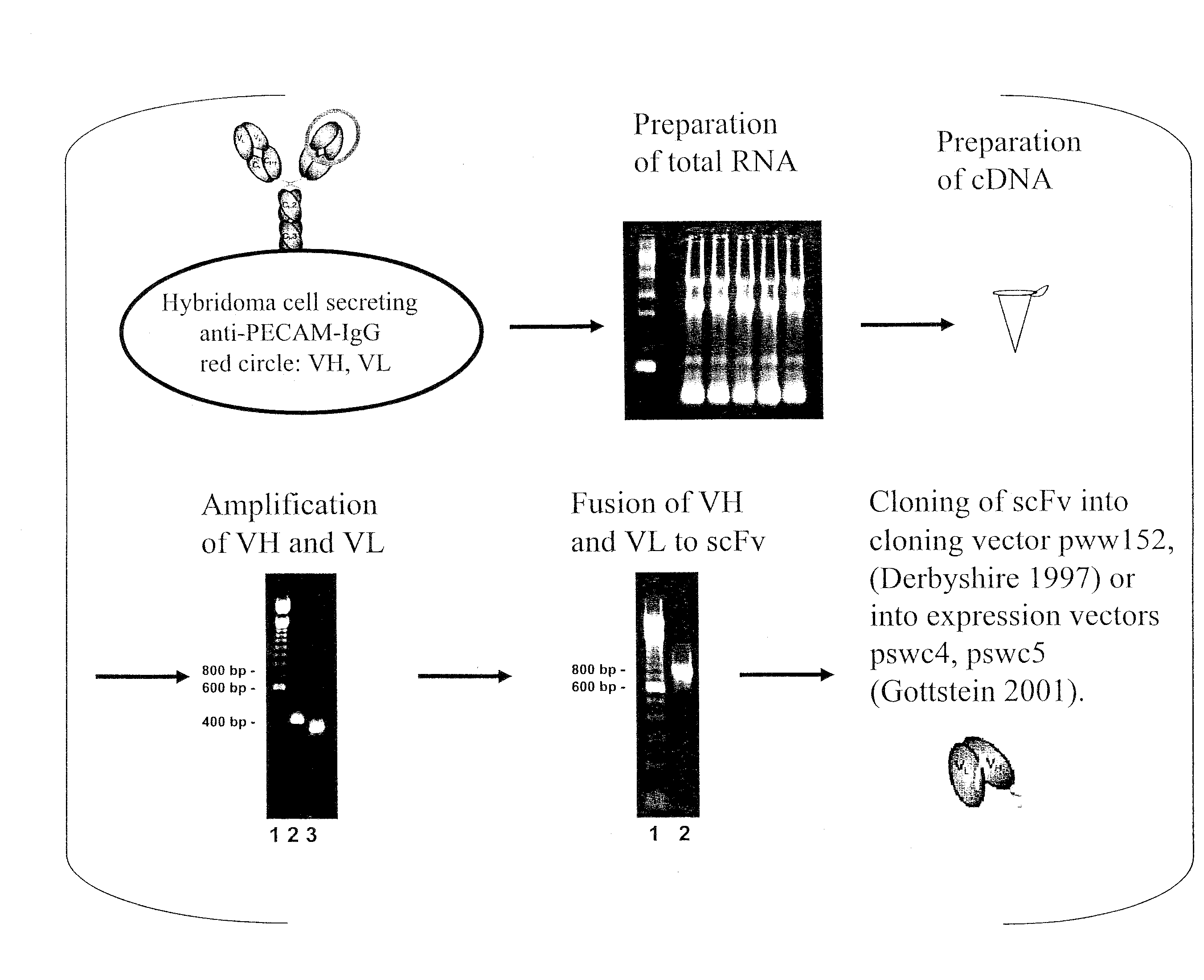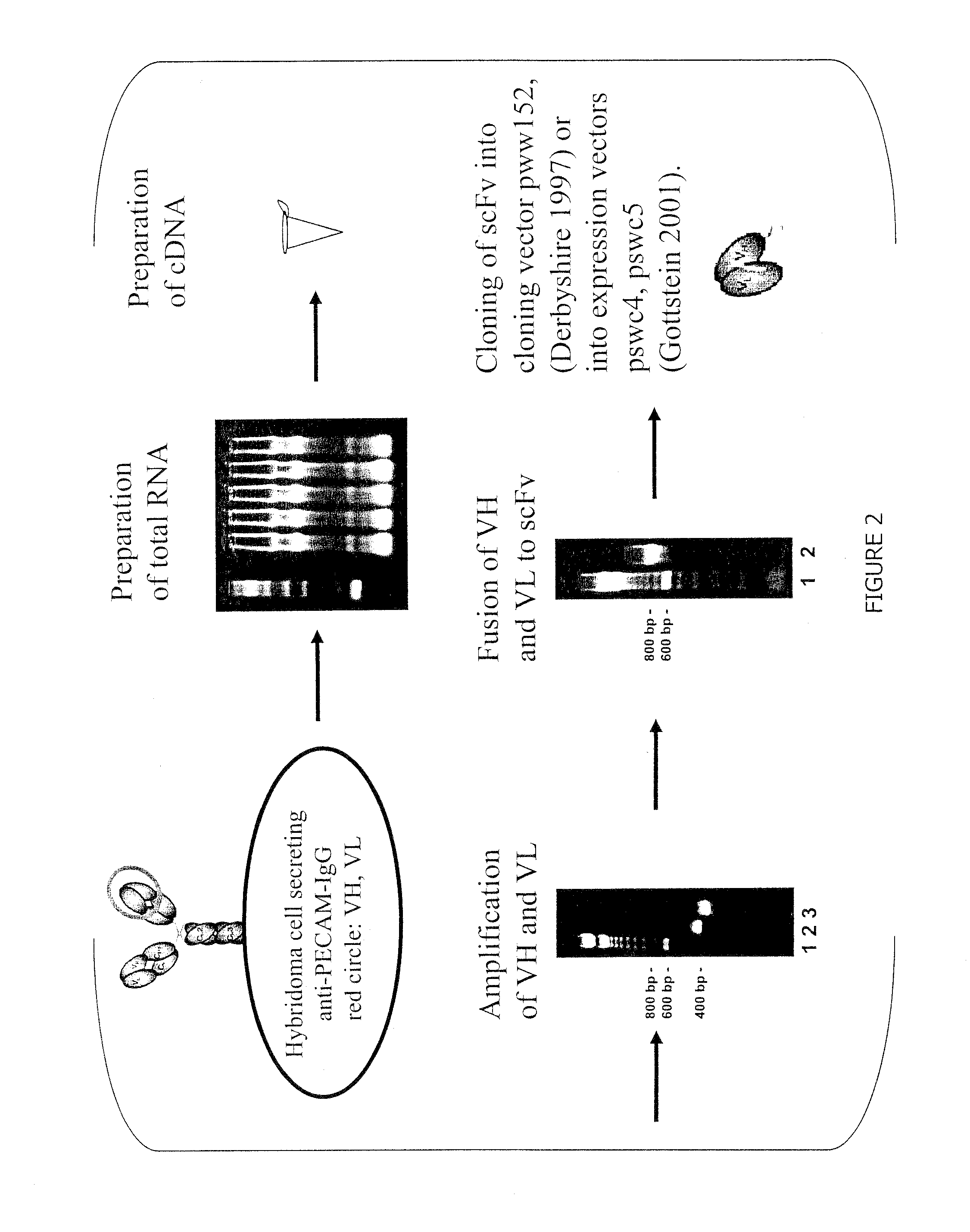Fusion proteins for inhibition and dissolution of coagulation
a technology of fusion proteins and coagulation, which is applied in the direction of enzyme stabilisation, extracellular fluid disorder, anti-coagulant, etc., can solve the problems of limiting the therapeutic use of existing anti-thrombotic agents including anti-coagulants, fibrinolytic plasminogen activators, and none of these derivatives produced decisively better therapies, and the targeting moieties are not designed for thromboprophylaxis or prevention, and achieve local release
- Summary
- Abstract
- Description
- Claims
- Application Information
AI Technical Summary
Benefits of technology
Problems solved by technology
Method used
Image
Examples
example 1
Generation and Binding Analysis of Anti-CD31-scFv
[0119]scFvs directed against luminal endothelial cell antigens were generated in accordance with teachings herein and teachings of Gottstein et al. (Biotechniques 2001 30:190-200). An example is an anti-CD31-scFv, derived from the hybridoma cell line 390. The corresponding antibody, Mab 390, is a rat monoclonal antibody directed against murine PECAM-1. The variable regions of the P-390 antibody heavy and light chains were cloned into the plasmid pww152 essentially as described previously by Derbyshire et al. (Immunochemistry 1: A practical approach. M. Turner, A. Johnston eds., Oxford University Press: 239-273, 1997). The variable heavy chain and light chain were assembled into a scFv fragment by overlap extension PCR and cloned into the expression plasmid pswc4 (Gottstein et al. Biotechniques 2001 30:190-200).
[0120]The scFv-protein was expressed with a tag (soluble tissue factor), which allows easy detection in binding assays, and wh...
example 2
Production and Biochemical Characterization of scFv-Anti-CD31-tPA Fusion Protein
[0121]The DNAs of a scFv against CD31 and a K2P (kringle 2 protease) domain of human tissue plasminogen activator (tPA) were cloned from cell lines. The DNAs were connected via linkers and incorporated into the newly generated expression vector pCG-F1 (FIG. 5A).
[0122]The fusion protein anti-CD31-linker-K2P was expressed in E. coli from inclusion bodies and purified by affinity chromatography. The molecular weight of the expressed fusion protein was determined to be 70 kDa by visualization on SDS electrophoresis gels. The identity of the protein was confirmed by western blotting (FIG. 5).
example 3
Fibrinolytic Activity of Anti-CD31-scFv-tPA
[0123]Fibrinolytic activity was assessed by a chromogenic assay, which measures the ability of the sample to cleave plasminogen to plasmin. The resulting plasmin is then measured via conversion of a chromogenic substrate specific for plasmin by spectrophotometry (FIG. 6).
PUM
| Property | Measurement | Unit |
|---|---|---|
| Surface | aaaaa | aaaaa |
| Coagulation enthalpy | aaaaa | aaaaa |
| Cell adhesion | aaaaa | aaaaa |
Abstract
Description
Claims
Application Information
 Login to View More
Login to View More - R&D
- Intellectual Property
- Life Sciences
- Materials
- Tech Scout
- Unparalleled Data Quality
- Higher Quality Content
- 60% Fewer Hallucinations
Browse by: Latest US Patents, China's latest patents, Technical Efficacy Thesaurus, Application Domain, Technology Topic, Popular Technical Reports.
© 2025 PatSnap. All rights reserved.Legal|Privacy policy|Modern Slavery Act Transparency Statement|Sitemap|About US| Contact US: help@patsnap.com



